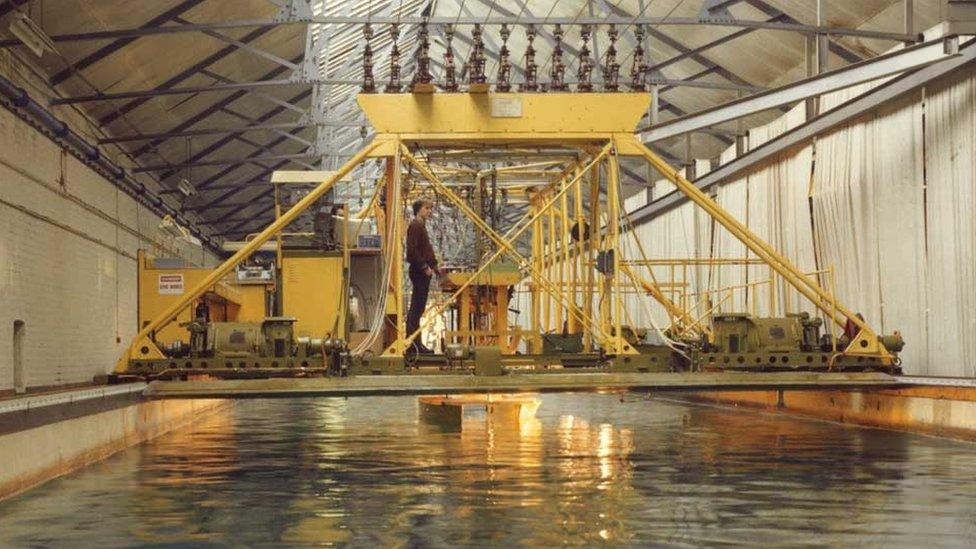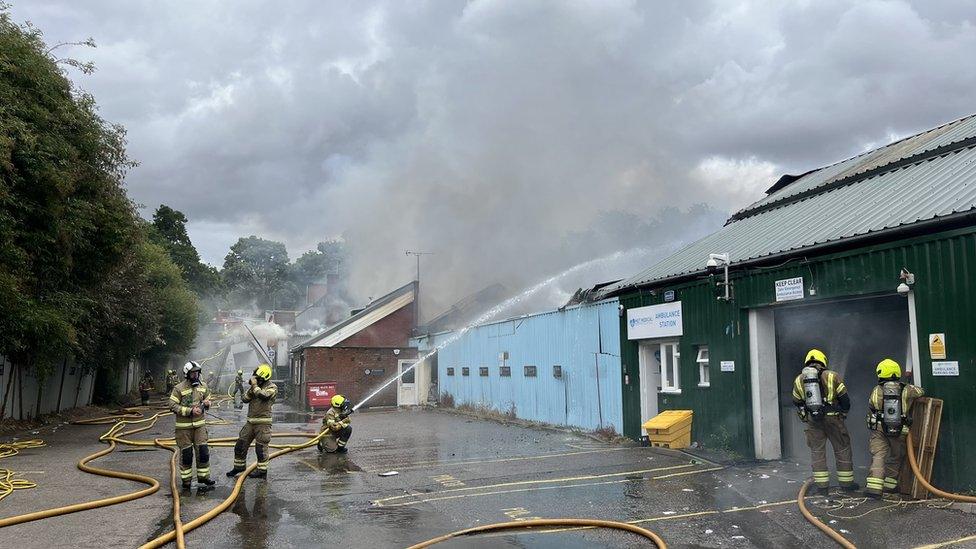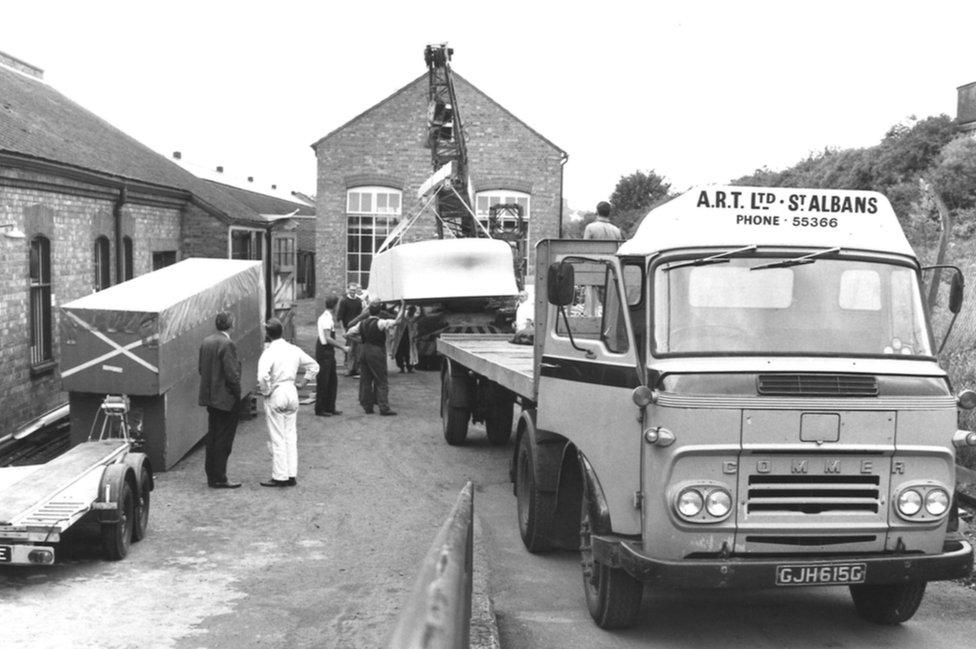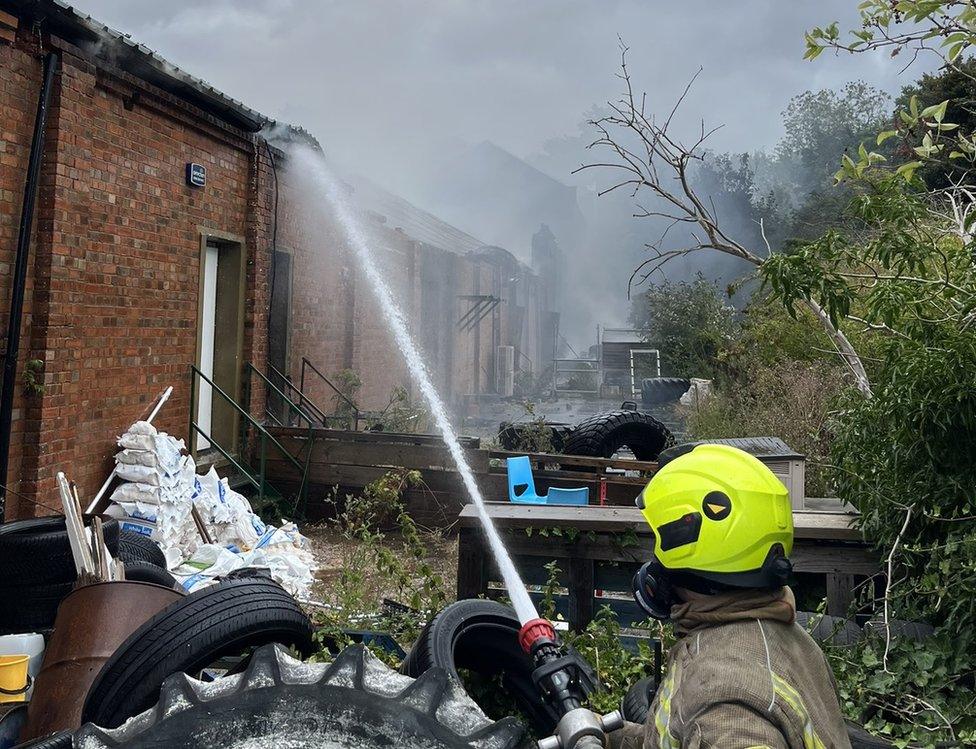St Albans: The hidden naval history lost in a fire
- Published

At its longest, Vickers Ship Model Experiment Tank stretched for 150m (459ft) and was also 6m (20ft) wide and 3.5m (11ft) deep
The Hertfordshire city of St Albans is well-known for its Roman settlement and Norman cathedral. When fire hit a number of small industrial units in the city this week, it destroyed a piece of hidden history.
On Monday, firefighters spent more than 13 hours fighting the blaze which started in a car workshop in London Road, which spread to neighbouring units.
More than 130 firefighters and officers - in 30 fire engines - were sent to the scene.
The building involved was long and thin and had been separated into smaller industrial units with a shared roof space.
Of the 14 units, five have been completely destroyed and two have suffered significant smoke damage.
Assistant chief fire officer, Simon Tuhill, said tackling the fire was "particularly challenging due to the spread of fire in the communal roof area" which meant it travelled quickly.

Hertfordshire's fire and rescue service spent more than 13 hours fighting the blaze which started in a car workshop in London Road
Afterwards, in a tweet, external, he admitted that it was "interesting to learn there is historical significance" to the building his crews "worked so hard to save".
And its history explains the building's layout.
From 1913 until 1985, 222 London Road, next to the railway bridge near St Albans station, housed the Vickers Ship Model Experiment Tank which tested the designs of submarines, seaplanes and ships - including the Royal Yacht Britannia - and which, at its longest, stretched for 150m (459ft).

The Vickers Ship Model Experiment Tank was planned by Thomas Thurston, Vickers chief naval architect, and built by Ezra Dunham on land acquired from the Gorhambury Estate
Wax models of the boats, each about 5-6m (16-19ft) long, were towed from an overhead gantry to test how full-size hulls would cope with varying conditions on open water.
In 1966, at its peak, it had 120 employees including model makers, photographers and scientists.
By the time it closed, when the tanks and equipment were removed, more than 2,300 model boats had been hydrodynamically tested and the building was divided into units.

Each wax model was about 5-6m long, made from wax and towed from an overhead gantry
Sarah Keeling, from St Albans Museums, said the Vickers' operation was "vital" as it not only tested this country's war ships, but also merchant ships and boats for other countries.
"The tank had a wave machine and could simulate different conditions to see how streamlined they were, they could also test propellers," she said.
"Later, lots of cameras were set up so they could take loads of pictures of how a ship and the water worked together.
"In terms of Britain as a naval power, there were a huge number of tests done and it was really important to its history."

A wave machine could simulate different conditions to see how streamlined the boats were
Given that St Albans nearest coastline is about 46 miles away from the nearest beach, the reason for choosing it as a tank site remains a mystery.
Other tanks, like one at Dumbarton were built near water, but Vickers had to rely on the St. Albans Waterworks Company each time it wanted about 600,000 gallons to fill the tank, which was also 6m (20ft) wide and 3.5m (11ft) deep.
Ms Keeling, the museum's curator of post medieval to contemporary collections, said she had "never really been able to find an accurate reason why St Albans was chosen".
"We think it was probably due to its proximity to London and the train station and there was also enough land to build the tank," she said.

In the 1960s Vickers had 120 employees including model makers, photographers and scientists
Coincidentally, the company features in a current exhibition at the museum, St Albans on Sea, external, which runs until 6 November and includes the stories of the many ships named HMS St Albans and HMS Verulam and the city's other connections to the sea.
"The exhibition came about because of knowing about Vickers and other marine inquiries I had," Ms Keeling, said.
"Weirdly, we're about as land locked as it's possible to be, but we have lots of connections to the sea."
Last April, permission was granted, external for a residential development on the site but Ms Keeling said the museum would keep telling its story.
"St Albans has changed throughout its history with important buildings coming and going but at the museum we will continue to preserve and share stories of companies like Vickers and celebrate the many different industries St Albans has been home to," she said.
"We tell a lot of stories that don't have a physical building or presence in the city and we'll continue to do so."
The fire service has now left the scene. It said that an investigation is ongoing but at this stage, the cause is not thought to be suspicious.

The fire service sent about 130 firefighters and officers to the scene

Find BBC News: East of England on Facebook, external, Instagram, external and Twitter, external. If you have a story suggestion email eastofenglandnews@bbc.co.uk, external